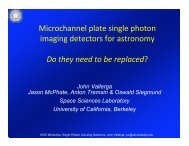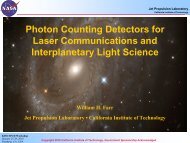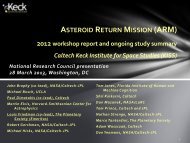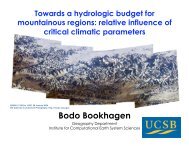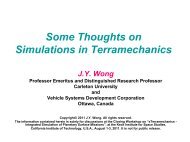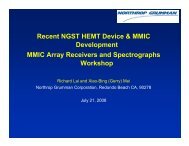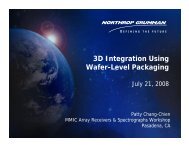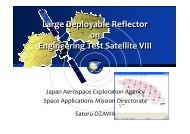Target NEO: Open Global Community NEO Workshop Report
Target NEO: Open Global Community NEO Workshop Report
Target NEO: Open Global Community NEO Workshop Report
Create successful ePaper yourself
Turn your PDF publications into a flip-book with our unique Google optimized e-Paper software.
DRAFT: RELEASED FOR PUBLIC COMMENTCurrently, the NASA exposure standard is a 3% risk of radiation exposure induced death (REID)at 95% confidence. Cancer is the primary driver of REID. This standard is subject to change,but it currently translates into approximate mission duration limits of 5-7 months for males age45. The mission length depends on solar activity, with the shorter duration associated with solarminima due to a reduction in the heliosphere’s ability to deflect GCRs coming into the SolarSystem. The mission durations for 45-year-old females are only approximately 3 months duringsolar minimum and 6 months for solar maximum. The latest NASA estimates for “Safe Days” indeep space, defined as maximum number of days with 95% confidence level to be below the 3% REIDlimit are shown in Table 3 (Source: “Space Radiation Cancer Risk Projections and Uncertainties -2010,” NASA). These estimates are for solar minimum with 20 g/cm 2 of aluminum shielding. Thesemission durations could increase by approximately 2 months if a reference population of individualswho have never smoked is considered. Reducing biological uncertainties could significantly extendmission duration, as could an increase in permissible REID. On the other hand, reductions inthe uncertainties could end up reducing mission duration limits even further. Risks estimates aresubject to change with new knowledge and with changes in regulatory recommendations. Increasingthe permissible REID would allow longer missions, but this will likely not be in the best long-terminterest of the astronauts and their families.Table 3: “Safe Days” In Space for Deep Space Missions During Solar Minimum with20 g/cm 2 of Aluminum ShieldingAge at Exposure NASA 2010 US Average (days) NASA 2010 Never Smokers (days)MALES35 140 18045 150 19855 169 229FEMALES35 88 13045 97 15055 113 177Solar Particle Events (SPEs) are intense periods of high-flux, largely medium-energy protons fromthe Sun. Protection against SPEs represents a shielding, operational, and risk assessment challengethat is much easier to meet than protection against GCRs. Proper shielding is effective, althoughoptimization is needed to reduce the associated mass to acceptable levels. With proper shielding,the major impacts of SPEs are confined mainly to EVAs. Typically, one or two SPEs occur duringperiods of high solar activity, but they can also occur around solar minima. A few SPEs during each11-year solar cycle may be intense enough to cause acute effects to astronauts who cannot achieveaccess to shelter facilities within a few hours. Accurate and timely SPE alerts and operationalresponses are essential for crew safety.5.2 Behavioral Health SupportBehavioral health support for crew is a critical aspect for long-duration space missions whoseimportance is sometimes overlooked. Stress management is a key component to keeping crewDRAFT: RELEASED FOR PUBLIC COMMENT 17




